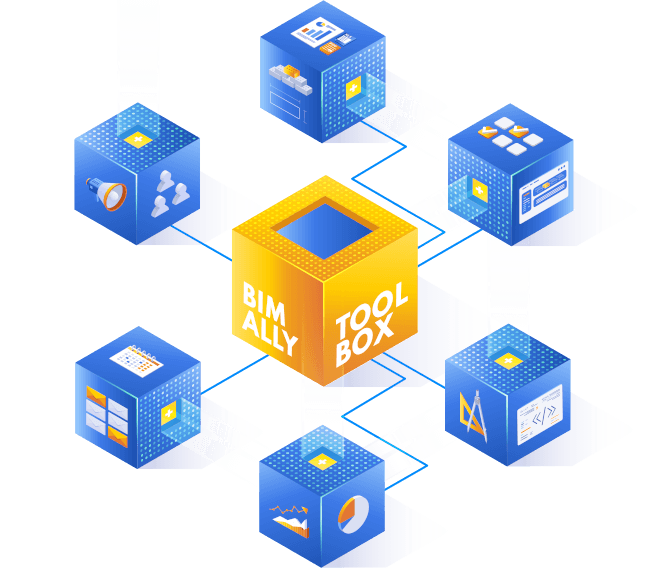BIM Content – Comparison of BIM ALLY Toolbox with platforms.

Having BIM libraries of your products is becoming a standard among manufacturers of building, installation and finishing materials. The very fact of their preparation, however, is only the beginning – the most important issue here is access to them by designers. It is for them that they are prepared in such a form and with such data that they can easily use them in their projects, maximizing the effectiveness of their work.
So far, large platforms associating many producers in one place have been popular. However, this solution more and more often does not satisfy producers, mainly due to the very high cost and the lack of access to reliable and authoritative statistics that can be effectively used by the sales department. Therefore, more and more companies using BIM technology decide to publish independently through their own website and an additional plug-in, which is all that is included in the BIM ALLY Toolbox.
Why?
Below, we present 13 aspects that manufacturers most often take into account when deciding before choosing a BIM service:

1. Administration panel
If BIM libraries are published on BIM portals, only the publishing institution has access and control over the administration panel. Having different amounts of data and libraries has the advantage that traffic can be increased by finding complementary material and creating an overall trend. With that in mind, it means competing materials are driving or diverting traffic as well. The data is more generalized and is not detailed or flexibly provided to assess specific areas of concern. While you pay more to the BIM portal hosting company to get more information on the performance of published BIM models, it can never be as detailed or detailed enough compared to individual targeting.
On the other hand, having a BIM Ally package integrated with the manufacturer’s website solves all the above problems. Thanks to full and complete control over its libraries, data and traffic can be adapted to the needs of the manufacturer, even to the most detailed things such as appearance and method of delivery.

2. Data ownership
The use of BIM portals gives them ownership as the data is constantly collected. The matrix developed is also the exclusive property of the BIM portals and a periodic subscription must be paid to retain or access this data. The upside is that some of the tasks are taken off the manufacturer’s board, and more time is spent on producing and improving the product. The downside is that the developer has no ownership of the content, and when the periodic subscription is not met despite the grace period, one morning it may wake up and go back to where it started. Contrary to the BIM Ally package, full ownership is granted to the manufacturer and depending on how he wants to maintain, update content and data, we remain an ally.

3. BIM content management
Thanks to the BIM Ally package, content management is completely free of the producer. BIM Ally can help by managing and improving it on behalf of the manufacturer, as an optional choice that is out of the box when using BIM portals. Like everything else, BIM portals managing content on behalf of the producer have their strengths and stoppers. However, having an option that allows for both seems wise.

4. Publication of BIM content
It may be obvious, but it is worth mentioning. By using BIM portals for publication, content and libraries are placed on the BIM portals page, and the data with their statistics are generated and distributed by the BIM portal. In BIM Ally’s solution, the manufacturer’s content and data are placed on its website, and anything that is owned or generated in relation to its content is owned and distributed by the manufacturer under its own responsibility.

5. Integration with other software
As many departments are engaged in product manufacturing, it is inevitable to use multiple applications and software. After all, this is the technological age !!!
As the BIM Ally package is always adapted to any manufacturer, almost all, if not all, software is adapted to integrate into existing infrastructure. The same cannot be said for the use of BIM portals just because of differences in the basic approach to BIM implementation.

6. Data and statistics
Again, I will repeat the range of data and statistics previously mentioned that each of the two approaches can provide. BIM portals can only generate limited data and traffic statistics from each manufacturer. They also download more to provide more details. It is simply the structure of the solution and the ability to deliver it. Due to this significant difference, the BIM Ally package, because it is undoubtedly focused on one manufacturer, can provide more detail and insight to sales, marketing, and other departments.

7. Live data and statistics
In addition to the differences in the level of detail, the difference in the fundamental approach to a BIM implementation allows the BIM Ally package to provide up-to-date and detailed data as well as statistics, while the way in which the BIM portal approach is completely structured is impossible to provide insight into how it is done. happening.

8. Uploading content
The two possible ways to publish BIM content have different approaches. The bottom line is that BIM portals put every producer in the same place, while BIM Ally focuses on one producer. This allows the latter to adapt solutions to specific situations, thus enabling the automation of repetitive, monotonous and other processes. Content upload is included. BIM portals have a manual approach to upload, which is also beneficial in some cases.

9. Branded applications
App branding with a BIM portal approach is very limited simply because of the way they help clients implement BIM. On the contrary, the individual approach of BIM Ally allows for the usual branding of web portals, BIM plugins and mobile applications, which is also very beneficial for marketing.

10. Platform customization
Thanks to the BIM Ally package, unlimited personalization is possible even down to the smallest detail. This cannot be done with different BIM portals. Yes, it’s less work and the same way of accessing things for designers, but the creative variations add variety to the experience and drive away the monotony.

11. Integration with the website
BIM Ally Suite allows for deep integration of all provided tools and services with the manufacturer’s website, compared to the shallow Iframe integration offered by BIM portal solutions. The advantage is deep integration, which gives the producer full access and control over the content, data and statistics not only of manufactured products, but also of the technological systems involved. Wouldn’t that make the work of each department easier? In the case of the second option, the BIM portal platform is the main controller of the above-mentioned

12. Purpose of the promotion
Every effort to promote anything is aimed at getting your products ahead of the competition. If you do not achieve this, there must be a re-visit and reassessment. The approach to this through the BIM Ally package is to directly target promotional activities only at the manufacturer’s products and only benefits on them. The alternative approach of BIM portals to promoting products, due to having a legion of not only companies but also products to support, everyone’s efforts are bungled in one place which can be an advantage for some but ultimately a disadvantage if someone else’s efforts are not set up by anyone else competition.

13. Publishing service
BIM portals, because they have control over content and data, must maintain, manage and perform other services on behalf of the manufacturer, download a periodic subscription that is immediately terminated in the event of a breach of contract. However, I am not sure about the grace periods. The one-time fee for setting up the BIM Ally package on the manufacturer’s systems is for the second solution. Depending on how you want to do the rest, BIM Ally remains an ally. As they say, it’s better to have a choice than none.

BIM ALLY TOOLBOX will equip your company with tools and services, thanks to which you will be able to effectively manage cooperation with both current and newly acquired designers.